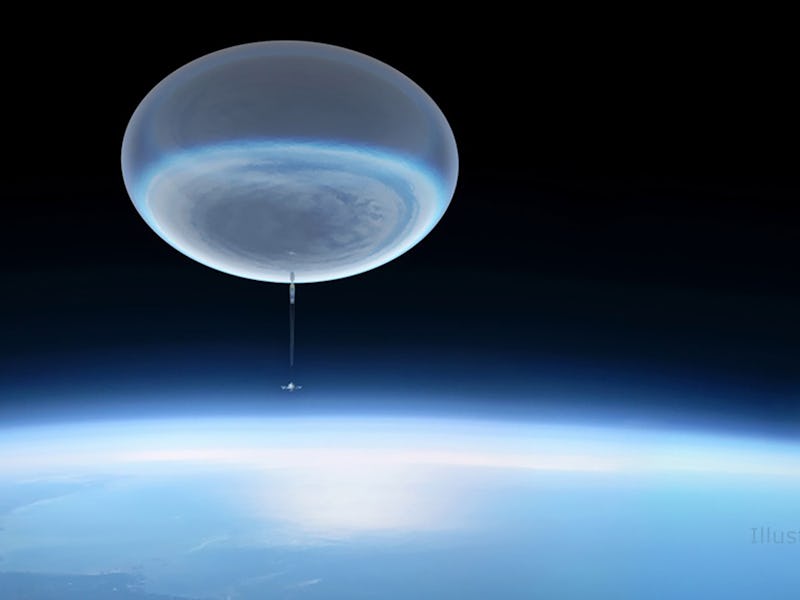NASA is betting on a massive balloon to attempt something totally new and little risky
Balloons are high-risk, high-reward missions.

NASA's upcoming mission to the stars will carry a lightweight telescope to space using a rather familiar, playful object — a balloon.
ASTHROS (short for Astrophysics Stratospheric Telescope for High Spectral Resolution Observations at Submillimeter-wavelengths) is an 8.4-foot telescope that will float away into the stratosphere, the second layer of Earth's atmosphere, strapped to a gigantic balloon.
The mission is tentatively set to launch in December 2023, and the telescope will spend about three weeks collecting precious data on surrounding stars to get a better understanding of stellar phenomena such as violent outbursts and supernovae.
Mission goals — ASTHROS will launch from Antarctica, and drift along the icy currents in the stratosphere.
An illustration of a high-altitude balloon going up into Earth's upper atmosphere, similar to how the mission's balloon will carry the telescope into space.
The telescope will reach an altitude of about 130,000 feet, which is around 62 miles above the surface of Earth, or about four times higher than how high commercial airlines fly. At this altitude, ASTHROS will be high enough to observe wavelengths of light that are otherwise blocked by Earth's atmosphere.
"With ASTHROS, we're aiming to do astrophysics observations that have never been attempted before," Jose Siles, an engineer at NASA's Jet Propulsion Laboratory (JPL) and project manager for ASTHROS, said in a statement. "The mission will pave the way for future space missions by testing new technologies and providing training for the next generation of engineers and scientists."
ASTHROS will measure the motion and speed of gas around newly-formed stars in four locations.
- Two star-forming regions in the Milky Way.
- Messier 83 galaxy, a spiral galaxy located around 15 million light years away.
- TW Hydrae, a young star surrounded by a wide disk of dust and gas where planets may be forming.
Data from the telescope's observations will create the first detailed 3D maps of the density, speed, and motion of gas in these regions to see how newborn giant stars influence their placental material. This map will help astronomers refine computer simulations of how galaxies grow and evolve over time.
"Computer simulations of galaxy evolution still can't quite replicate the reality that we see out in the cosmos," Jorge Pineda, a scientist at NASA's JPL and principal investigator of ASTHROS, said in a statement. "The nitrogen mapping that we'll do with ASTHROS has never been done before, and it will be exciting to see how that information helps make those models more accurate."
Why balloons? — In order to reach the stratosphere, ASTHROS is floating above the Earth's surface along with a giant balloon. The balloon is inflated with helium, and is about 400 feet wide.
The balloon will complete two or three loops around the South Pole in about 21 to 28 days, carried by prevailing stratospheric winds, according to NASA. Once the mission is complete, the telescope will be separated from the balloon and returned back to Earth, while its inflated companion floats off into space.
Although the method seems outdated, NASA has actually been relying on this balloon technology for soe of its missions for more than 30 years now.
NASA's Scientific Balloon Program launches 10 to 15 missions a year.
The launch of a similar balloon mission, the Stratospheric Terahertz Observatory II (STO-2), a NASA astrophysics mission, from Antarctica in 2016.
"Balloon missions like ASTHROS are higher-risk than space missions but yield high-rewards at modest cost," Siles said.
The reason why these balloons are still being used by NASA today is that they cost close to nothing compared with other space missions, and their planning and deployment time also spans much shorter. As a result, these types of missions can stand to uphold against the risks that other costly, time consuming missions cannot such as unknown technical or operational challenges
By working through these challenges, balloon missions can set the stage for future missions to reap the benefits of these new technologies, according to NASA.
This article was originally published on